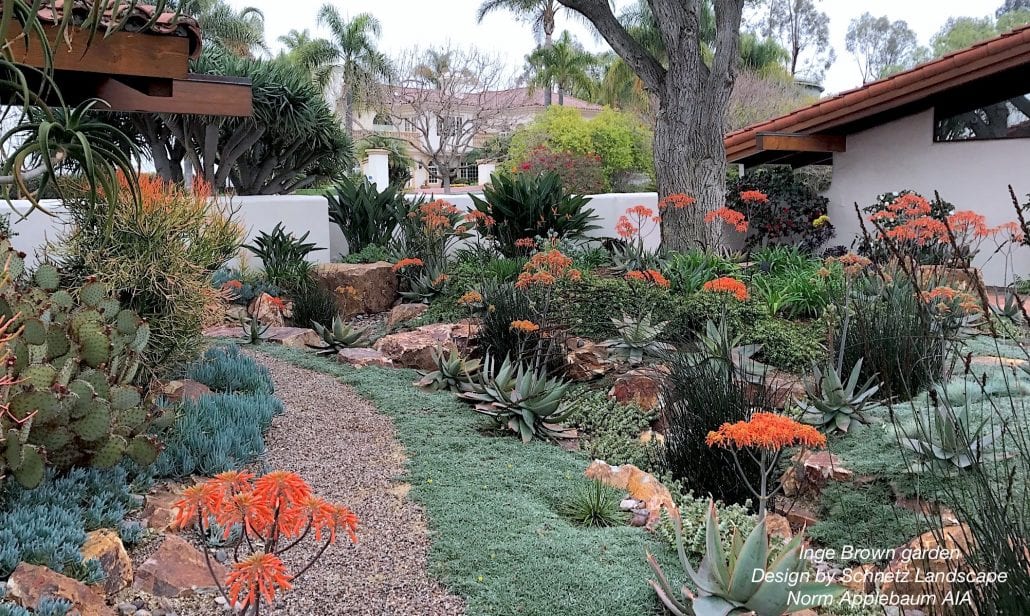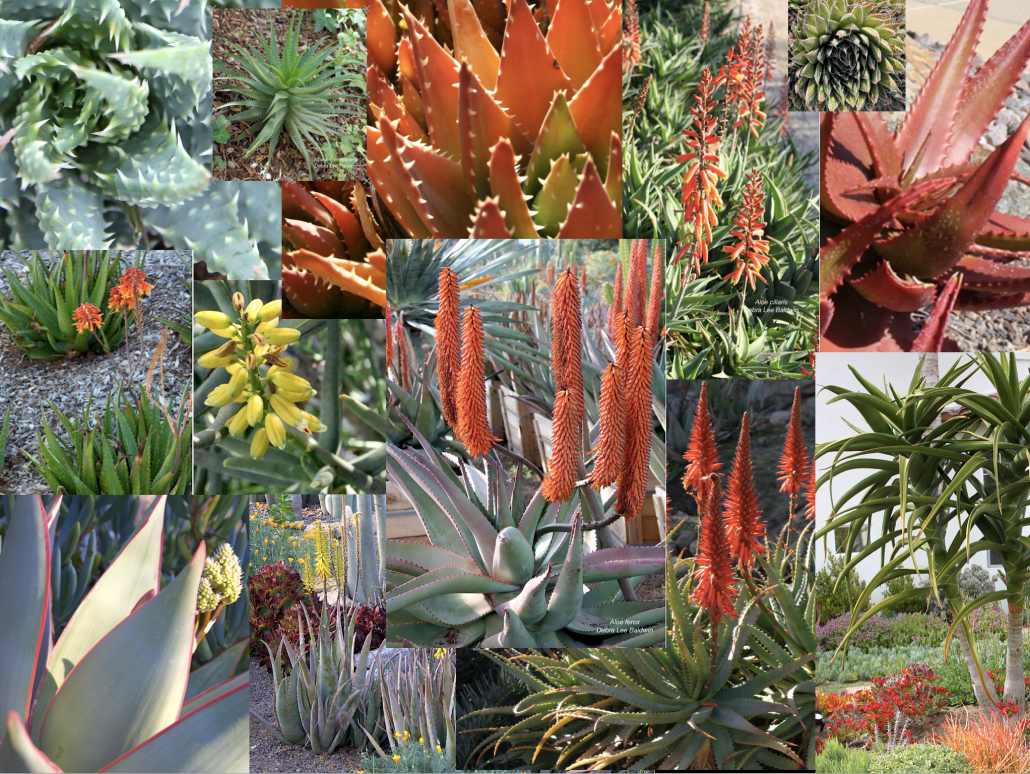Looking for great succulents for your garden?
Plant aloes in well-draining soil and “they’ll soon become your favorite succulents,” says Bill Schnetz, one of Southern CA’s most sought-after landscape designers. Bill uses aloes of all sizes in mild-climate residential gardens. For a natural look, he suggests mixing one or two kinds with tough, drought-tolerant ornamental grasses and flowering perennials. For a contemporary look, he recommends planting similar aloes “in rows and geometric blocks.”
In this Rancho Santa Fe courtyard garden, Bill planted numerous coral aloes (Aloe striata). Their long-blooming flowers and translucent leaf margins repeat the orange of roof tiles, Euphorbia tirucalli ‘Sticks on Fire’ at left, and bird-of-paradise along the wall (when in bloom).

Blue, the color complement of orange, creates contrast via Senecio mandraliscae and Senecio serpens (at left) and tufts of blue fescue (below). Other ornamental grasses, paddle cactus and elephant’s food (Portulacaria afra ‘Variegata’) lend texture and interest. Dymondia, a walkable ground cover, serves as a low-water lawn substitute. Stone pavers and Saltillo tiles repeat the rust hues of boulders that line a dry creek bed. At upper left is Aloe bainseii, a tree aloe. (Also see this garden in Designing with Succulents, 2nd ed., page 58.)

Bill’s 14 Favorite Aloes
I asked Bill if he’d share which aloes he uses most often in clients’ gardens, and why. This list was compiled by Schnetz Landscape, Inc. with Rebecca Simpson.
Small aloes. These tough, toothed aloes handle adverse conditions. Height: 8 to 18 inches.
Aloe x nobilis, Aloe aristata, and Aloe humilis all grow tight and stay low.
Aloe ‘Rooikappie’ is Bill’s favorite small aloe. It gets a little bigger than the three above and is a good fit for small and large landscapes. It’s a repeat bloomer and transplants easily.
Mid-size aloes are good for borders and large-scale massing. Height: 18 to 36 inches.
Aloe striata has nice plump leaves and good floral color.
Aloe vera is dramatic planted en masse, and yes, the gel is useful for burns and cuts.
Aloe x spinosissima is a 2- to 3-foot sprawler great on hillsides and rocky soil.
Aloe cameronii is Bill’s favorite 2-foot aloe. Stays red all year if given full sun.
Tree aloes tend to be slow growing and may not look their best in cold winter months. Don’t plant them near foundations or under eaves—they do get big.
Aloe bainesii is a moderate grower, 15 to 30 feet tall. Leaves may turn yellow and get black spots, but with summer warmth and feeding they’ll green up.
Aloe dichotoma is slow-growing to 15 to 20 feet. It has nice gray leaves and is very drought tolerant.
Aloe ferox is slow growing to 6-10 feet with a single trunk that holds dead leaves.
Aloe ‘Hercules’ is a faster-growing hybrid with a thick, strong trunk. Give it plenty of room.
Shade-tolerant aloes useful as firebreak plants are fast-growing and spreading.
Aloe ciliaris is a sprawling succulent that will climb palm tree trunks. Take care that it doesn’t get buried in leaves and melt away. Sometimes called ‘Fire Wall’ aloe, when grown on a slope, the plants form a 3- to 4-foot mat of fire-resistant growth.
Aloe arborescens is probably the most commonly grown aloe in the world. If you have room for it, you can’t go wrong. It solves a multitude of landscape problems, and thrives everywhere—coast, low desert, foothills—from Mexico to San Francisco. Originally from South Africa, it’s also found all around the Mediterranean. This multiheaded aloe makes a good background plant and tolerates filtered shade beneath tall trees. For a dense barrier, plant 6 to 8 feet apart in a line or triangles. Height: 4 to 8 feet and spreading.

More Info
In my books: Designing with Succulents, 2nd ed., pp. 182-190; Succulents Simplified, pp. 185-197.
On this site:
The post Bill’s Best: A Top Designer’s Favorite Aloes appeared first on Succulents and Succulent Garden Design | Debra Lee Baldwin.
from Succulents and Succulent Garden Design | Debra Lee Baldwin https://ift.tt/2IqcdbK
via IFTTT



No hay comentarios:
Publicar un comentario